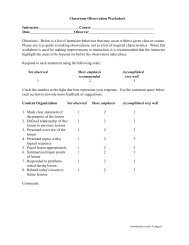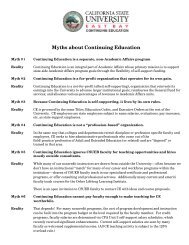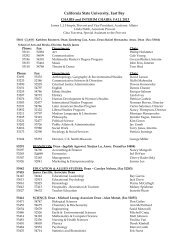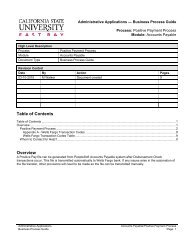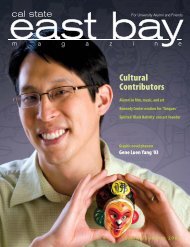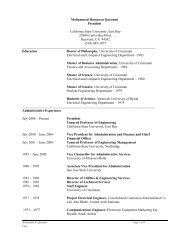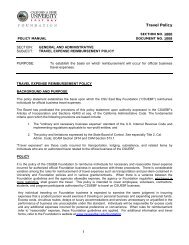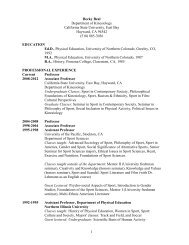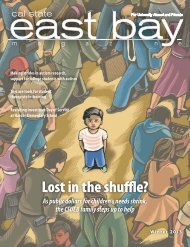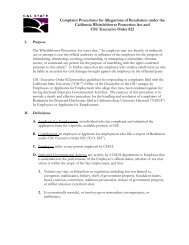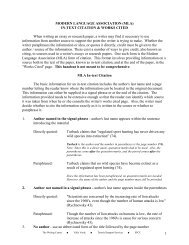Beyond CSI - California State University, East Bay
Beyond CSI - California State University, East Bay
Beyond CSI - California State University, East Bay
Create successful ePaper yourself
Turn your PDF publications into a flip-book with our unique Google optimized e-Paper software.
features<br />
When not in the classroom, Assistant Professor Keith Inman, above, can be found<br />
on the job at Forensic Analytical Sciences Inc. performing tasks such as firearm<br />
and toolmark examination.<br />
Advincula doesn’t carry a gun on the job, but he’s seen<br />
his share of gunshot wounds, methamphetamine overdoses,<br />
heart disease, and other life-ending hazards. However, he<br />
learned on his first visit to the coroner’s office, where his<br />
then-instructor Rippy handles case investigations, not to<br />
rely on assumptions.<br />
“(Rippy) invited us on a field trip to go to the morgue,”<br />
explains Advincula, who majored in applied mathematics<br />
with a minor in CRJA. “When we were there, she told<br />
us the story of a person who had been in a car accident.<br />
But it wasn’t the car accident that killed her; she had<br />
medical issues.”<br />
The gap between outward appearances and what science<br />
revealed in the case solidified his interest in the field. When<br />
Rippy informed students that she was creating an internship<br />
at the coroner’s office, Advincula quickly applied and was<br />
accepted. His colleagues were so pleased with his work, they<br />
invited him to stay on as an intern the following quarter. In<br />
February, they offered him a full-time position, which he<br />
eagerly accepted.<br />
REAL-WORLD PREP<br />
Advincula credits the real-world preparation CSUEB<br />
faculty gave him for his on-the-job success.<br />
“Most of the instructors are … retired cops and (faculty)<br />
still working in the field,” Advincula says. “They can give us<br />
PHOTO MAX GERBER<br />
a better, bigger perspective. We’re not just learning from a<br />
book. We’re learning from a person who lived the life.”<br />
Inman, one of Advincula’s former CRJA instructors,<br />
has been living the life of a criminalist for nearly 35 years,<br />
performing DNA analysis and crime scene reconstruction<br />
in private practice, for sheriff ’s departments, and public<br />
agencies such as the state Department of Justice DNA<br />
Laboratory. He worked on the high-profile Hillside Strangler<br />
case in the 1970s. When not in the classroom, he works for<br />
a private, Hayward-based crime lab, Forensic Analytical<br />
Sciences Inc., which reviews cases, assesses evidence, and<br />
offers services from bloodstain pattern interpretation to<br />
gunshot residue analysis.<br />
A faculty member since 1997, Inman peppers lectures<br />
with references to cases he’s worked on, often showing<br />
actual crime scene photos. Students enrolled in his courses<br />
soon learn it won’t be a passive experience. During a session<br />
of “Comparative Evidence and Its Evaluation,” an upper<br />
division CRJA course, students take in a short video, get<br />
a dose of forensic science philosophy from Inman, then<br />
examine the basics of a shooting case in which a police<br />
officer’s body was found leaning against a boat just inside a<br />
garage in a Martinez neighborhood. The 1975 case was one<br />
of the first Inman worked.<br />
CRIME SCENES<br />
“Here’s what happens: An officer calls in a traffic stop,”<br />
Inman explains to the 24 students scattered about the<br />
Meiklejohn Hall classroom. “Shortly after this, he says, ‘I<br />
need backup.’ A second officer shows up in mere minutes,<br />
and when he shows up, he finds the first officer shot.”<br />
“Based on what I gave you in this brief scenario, use your<br />
forensic imagination and imagine what evidence could exist.”<br />
At Inman’s prompt, the students drag their desks into<br />
clusters of two or three to brainstorm.<br />
After several minutes, Inman interrupts the thrumming,<br />
energetic conversations between students and asks the<br />
groups to call out their evidence ideas. Acting as scribe, he<br />
notes their responses — from bullet strikes to surveillance<br />
camera recordings — in blue ink on a white board at the<br />
front of the room.<br />
“OK, Jhoanna, your group” he says, soliciting<br />
evidence ideas.<br />
“Timeframe in which everything happened,” says senior<br />
Jhoanna Navarro, 23. “What time the call was made What<br />
time back up came”<br />
Forensic autopsy technician Kenneth Advincula ’11 gained early<br />
on-the-job-experience through a CSUEB internship program at the<br />
San Mateo County Coroner’s Office, where he now works full time.<br />
PHOTO MAX GERBER<br />
14 Cal <strong>State</strong> <strong>East</strong> <strong>Bay</strong> Magazine | SPRING 2011 Cal <strong>State</strong> <strong>East</strong> <strong>Bay</strong> Magazine | SPRING 2011 15



